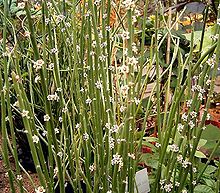bio.wikisort.org - Plant
Euphorbia antisyphilitica is a species of flowering plant in the spurge family Euphorbiaceae. It is native to the Trans-Pecos of Texas[2] and southern New Mexico in the United States as well as Chihuahua, Coahuila, Hidalgo, and Querétaro in Mexico.[1] Common names include candelilla and wax plant, but the latter is more often applied to members of the unrelated genus Hoya. It is shrubby and has densely clustered, erect, essentially leafless stems that are covered in wax to prevent transpiration.[3]
| Euphorbia antisyphilitica | |
|---|---|
 | |
| Scientific classification | |
| Kingdom: | Plantae |
| Clade: | Tracheophytes |
| Clade: | Angiosperms |
| Clade: | Eudicots |
| Clade: | Rosids |
| Order: | Malpighiales |
| Family: | Euphorbiaceae |
| Genus: | Euphorbia |
| Species: | E. antisyphilitica |
| Binomial name | |
| Euphorbia antisyphilitica | |
| Synonyms | |
|
Euphorbia cerifera Alcocer[1] | |
Uses
The white sap of E. antisyphilitica was historically used in Mexico to treat sexually-transmitted diseases.[citation needed] Commercial harvesting of candelilla wax began at the start of the twentieth century, with demand greatly increasing during World War I and II. This industry largely disappeared following the end of World War II due to diminished candelilla populations and the availability of cheaper petroleum-based waxes.[3] Later on however, new uses were found for the wax mainly in the cosmetic and food Industries, and it is still being produced in northern Mexico and exported to other countries. E. antisyphilitica is covered under Appendix II of CITES given the significant international trade in its wax derivative.
Cultivation
Candelilla is gaining in popularity as a landscape plant in parts of the arid southwest. It is popular for the following reasons:[4]
- Once established, it needs little water other than rainfall in cities such as Phoenix or Tucson, making it good as a median planting.
- It can survive in areas that have reflected light.
- It grows best in well-drained soils but can tolerate some clay or limestone.
- It is visited by butterflies, although not commonly considered a "butterfly plant."
- It is cold-tolerant to 15 degrees F.
- It appears not to be bothered by pests.
- It can be grown in containers.
References
- "Euphorbia antisyphilitica". Germplasm Resources Information Network (GRIN). Agricultural Research Service (ARS), United States Department of Agriculture (USDA). Retrieved 2010-10-14.
- "Euphorbia antisyphilitica Zucc". Native Plant Database. Lady Bird Johnson Wildflower Center. Retrieved 2010-10-14.
- Turner, Matt Warnock (2009). Remarkable Plants of Texas. University of Texas Press. pp. 125–127. ISBN 978-0-292-71851-7.
- Soule, Jacqueline A. 2013. Success With Succulents. Tierra del Sol Press
External links
![]() Media related to Euphorbia antisyphilitica at Wikimedia Commons
Media related to Euphorbia antisyphilitica at Wikimedia Commons
![]() Data related to Euphorbia antisyphilitica at Wikispecies
Data related to Euphorbia antisyphilitica at Wikispecies
На других языках
- [en] Euphorbia antisyphilitica
[es] Euphorbia antisyphilitica
Candelilla (Euphorbia antisyphilitica) Zucc. es un arbusto de la familia Euphorbiaceae. Su tallo compacto y sin hojas llega a medir hasta 90 cm de altura, sus flores son en tonalidades rosa. En México se distribuye principalmente en los estados del norte pero también hay registros en el Altiplano y el Bajío. Habita climas desérticos asociado a suelos rocosos. Actualmente es una especie que se encuentra protegida del Comercio Internacional a través de la Convención CITES (Apéndice II). Su aprovechamiento es con fines principalmente medicinales.Другой контент может иметь иную лицензию. Перед использованием материалов сайта WikiSort.org внимательно изучите правила лицензирования конкретных элементов наполнения сайта.
WikiSort.org - проект по пересортировке и дополнению контента Википедии